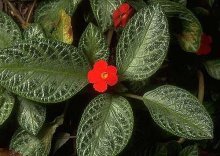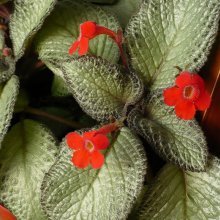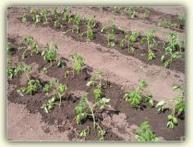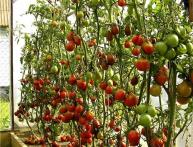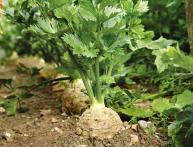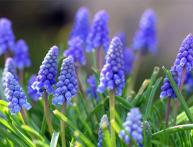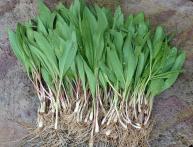Episcia: care and cultivation, pest control
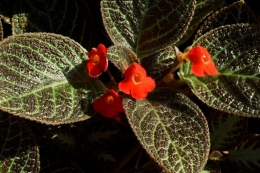
The epic combines unusualness and beauty. This is a unique plant that pleases with original flowers and leaves. Its foliage is decorated with multi-colored patterns. It has the ability to reflect color, so it seems that the episcia sparkles. Caring for the plant is not difficult, but it is worth familiarizing yourself with a number of growing rules.
Content:
- Selecting a location
- Watering and soil selection
- Replanting and shaping shrubs
- Reproduction
- Pests and growing problems
Selecting a location
Even an inexperienced person can figure out how to care for the epision. But this flower needs proper conditions for development. The main thing is that they resemble the natural environment. It is recommended to buy a flower in the spring, when choosing, it is better to pay attention to a small plant that has already formed. The foliage should not be dry, without spots, as this indicates the presence of infection.
It is recommended to place the plant near windows in the east or west.
If the room has only southern windows, then you should move the flower to a dark place from 10 am to 2 pm if the weather is sunny outside. If this is not done, the foliage will dry out, curl and fade. Later, new leaves will appear, but they will be small and yellowish. If the owner does not want to constantly move the plant, then it is recommended to initially hang it in a pot 3 meters from the window.
If you place the plant in the north, then it will not have enough light.Therefore, experienced people do not advise leaving it on such windows. The plant feels comfortable at a temperature of 22-24 degrees. If the indicators decrease or increase too much, then the epidemic will die. But high temperatures are more gentle than low temperatures. In autumn and spring it is worth protecting the flower from drafts. Episcia loves light, but the rays of the sun have a detrimental effect on it, as it spoils its color. If there is not enough light, shoots will quickly stretch out.
Watering and soil selection
In spring and summer, watering is required every 3 days. You need to make sure that the soil is not too waterlogged. Otherwise, the rhizome will begin to rot. In winter, the plant is watered less frequently. The main thing is to monitor the top soil layer. If it dries out, then you should immediately water the episcia. Water should not accumulate in the pan. It is better to water the plant with settled water.
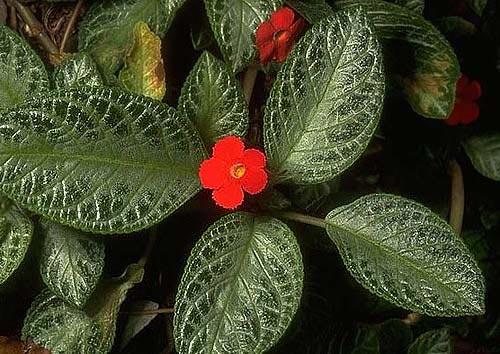
It is recommended to ensure that it does not fall on the foliage, which is injured by drops of moisture. Therefore, spraying is prohibited. To maintain the necessary air humidity, pour pebbles into the tray and fill them with water, but the bottom of the pot should not touch it. Episcia should be planted in light soil that allows air to pass through well. Only under such conditions will normal root development occur.
To achieve this, it is recommended to add drainage to the soil. It is laid out in a 3-centimeter layer at the bottom of the container. For this, stones or expanded clay are used. Specialized stores sell ready-made mixtures for planting, but you can make it yourself. To do this, mix:
- Fertile soil
- Sand
- Sheet soil
It is recommended to add charcoal to this mixture.In spring and summer, fertilizing is carried out once every 7 days. In autumn and winter, this procedure is not carried out so as not to interfere with the growth and development of the plant. To do this, use any mineral fertilizer that is intended for flowers. If priming dried out, then feeding should be postponed. Otherwise, the rhizome may burn. If you follow all these rules, the plant will develop normally.
Replanting and shaping shrubs
The plant should be replanted 2 times a year. To do this, you need to find a wide pot so that it does not have large sides. Otherwise, the episcia will not have flowers and stems hanging down. The plant develops and grows quickly, for this reason the new container should be larger. The old pot should be 5 cm smaller. You should make holes in the bottom of the pot.
The transplant is carried out in the following sequence:
- 30 minutes before the planned transplantation, abundant watering is carried out.
- The plant is carefully removed. It is necessary to ensure that the rhizome is not damaged. To do this, it is recommended to initially knock on the pot.
- The rhizome must be carefully examined. If there are overdried or rotten roots, then they are cut off. The place where the cut was was treated with sulfur.
- Drainage is laid out at the bottom, and then the prepared soil is poured out.
- After the manipulations, the plant is well watered. It is necessary to ensure that drops of water do not fall on the leaves. After this, excess moisture will begin to accumulate in the pan; it must be poured out 30 minutes after landings.
- The plant should be kept in the shade for 7 days.
Video about caring for an episcia flower:
Since the plant grows quickly, it is necessary to monitor its shape by periodically pruning. To do this, use scissors, which must first be boiled for 10 minutes. When the plant fades, trim the stems. They are planted in the same container so that the bush becomes more luxuriant.
Reproduction
Plant propagation can be done in several ways:
- Using side shoots or mustaches. These parts of the plant are placed in water for rooting to occur, and then placed in the ground.
- Daughter sockets. They are buried in the soil, but they are not removed from the mother bush.
- When rooting occurs, then the young plant is separated and moved to a new container. But some people leave it with the mother plant.
- The roots of the roots will begin to form in a week.
- Cuttings. To do this, cuttings are cut and placed in the ground. They are covered with glass. It will take a week for rooting.
- Seeds. Using this method, you can lose the varietal characteristics of episcia. Seed material is planted superficially; it is not covered with soil.
If the temperature is maintained at least 20 degrees, then sprouts will appear after 1.5-2 weeks. When 3 weeks have passed, it is necessary to dive.
Pests and growing problems
Episcia may suffer from mealybugs, aphids, and nematodes. If any of these pests are found, it is worth using insecticides. They treat the plant. After 10 days the procedure is repeated. If a plant is attacked by a nematode, it is better to cut the cuttings and grow new plants. Damaged rhizomes are discarded and all pots are disinfected.
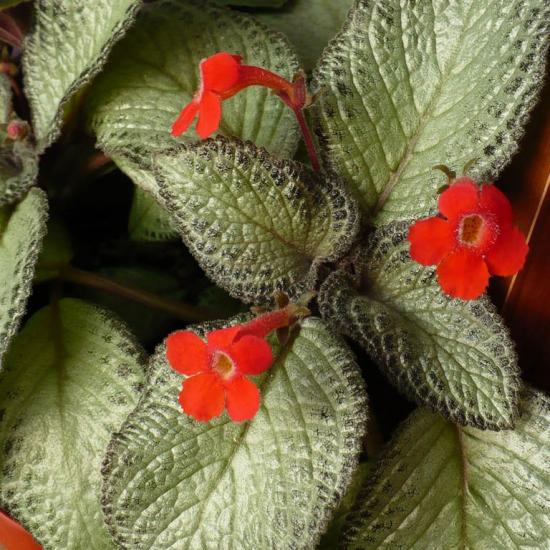
Episcia is at great risk of rot, which occurs due to excess moisture. This often happens in winter. You can also encounter this problem during reproduction. To prevent rot from appearing, it is necessary to carry out prevention. To do this, you should make sure that the soil in the pot does not become waterlogged.
The container must have holes at the bottom. It is necessary to water the plant after the top layer of soil has dried.
It is recommended to add crushed charcoal to the ground during replanting. If root rot occurs, the flower will be lethargic. During growing plants may encounter the following problems:
- No flowers appear. This occurs due to lack of moisture, dry air, cold, and lack of lighting.
- The appearance of a gray coating on the foliage, which appears due to stuffiness, old soil, and excessive moisture.
- Yellowed leaves. They turn yellow due to excess fertilizer, sun rays, and dryness.
- The foliage becomes covered with brown spots when the plant is watered with cold water.
- Slow growth occurs due to light deficiency.
- The leaves become crowded due to dryness.
Of course, the epic needs attention. But if you carefully study all the nuances of care, you can get a beautiful flower miracle that will decorate your home. If the plant receives proper care, then it will reward you with luxurious foliage and bright flowers.

